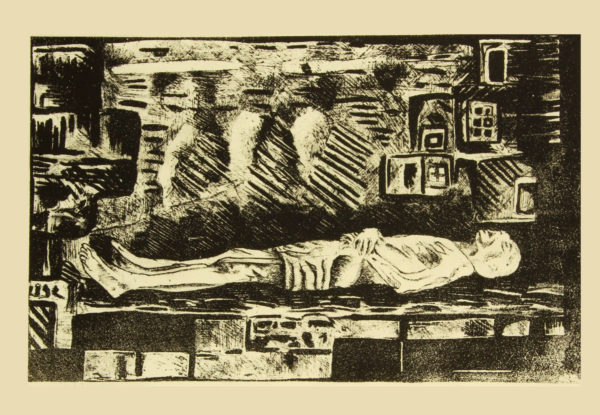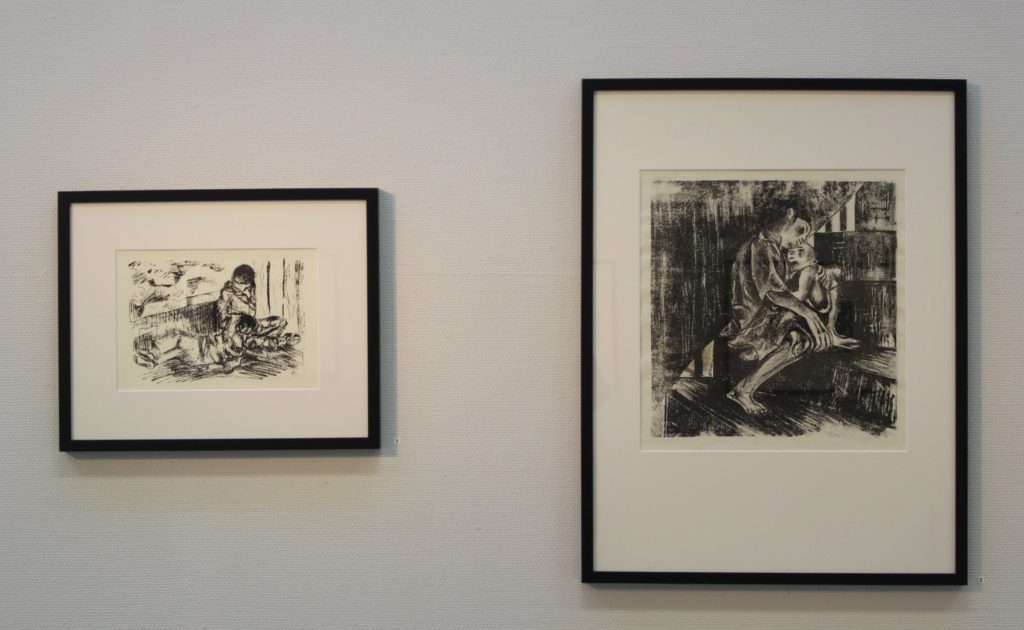A graphic representation of war in Syria, Kunstmuseet Nord-Trøndelag, Museet Midt IKS 2016
At some point in time during the 20th century, Art shifted from functioning as figurative documentation of events, to more or less fictive abstraction. Nowadays contemporary art of the western world, seems to be working on the challenging task of expressing truth and fantasy, through both realistic and non-figurative representation.
It is therefore interesting to experience a collection of graphic art, created by a young contemporary artist who works within the realm of truth and documentation, by way of traditional printmaking.
Rim Salama is an artist who arrived in Norway in 2015, as a refugee from Syria. She has a degree from the Faculty of Fine Arts, University of Damascus. During her four years as an art student, she worked on various media such as sculpture, painting, drawing, graphics and design. It eventually became evident that her strength as an artist was to be found within printmaking. She focused and perfected her techniques within the department of graphics and spent three months working on this particular body of work. Her artwork consists of a series of graphic prints in various degrees of abstraction. The theme of her renderings is human suffering depicted through confusion, homelessness, desperation and starvation. These challenges are the results of war. The conditions of living in a country marked by severe conflict over several years, are miserable. On account of war the primary needs of food, shelter and safety have ceased to exist.
Rim’s work was created as a final graduation project at the University of Damascus in 2014. After she arrived in Norway, local art lovers and professional curators at the art museum, discovered her talent and quickly realized the quality of her artwork. Rim Salama’s collection of artwork was sent by post from Damascus to Norway during the summer of 2016. An exhibition of her graphic work was organized for September-November 2016. The exhibition consisted of 16 works of art around the theme of misery. Techniques rendered within the body of work were linoprint, copper print, silk screen and lithography.
There is great variety in style and drawing from one technique to the other. Groups of artworks have their own expressions, according to which media Rim used for each particular category. The various techniques express individual moods, which seem to suit every piece in unique ways. The individual expressions are matching the theme and the title of each work of art. Rim utilized traditional methods for making her prints. She also mixed in her own new chemistry, in order to develop new unique modes of expression. Thereby creating a very personal style, which shifts from one type of expression to the next. Her linoprints have clearly elongated contrasting vertical and horizontal lines, whereas her copperprints consists of much smaller and very busy curved lines and organic shapes. Her copperprints are also more figurative than her linoprints, which have higher degrees of abstraction.
Looking back through the history of art of the 20th century, another artist clearly comes to mind in comparison with Rim Salamas work. Another female artist who worked through war time. This other artist was older and had other personal experiences to draw from. However, there is an uncanny likeness between the two, with the common theme of human suffering through war and deprivation. Their style, composition and mode of expression, also has a lot in common with each other. The artist in this connection, is Kathe Kollwitz. (1867 – 1945) Kollwitz was a German artist, who worked with drawing, etching, lithography, woodcuts, painting, printmaking, and sculpture. Her most famous work, including The Weavers and The Peasant War, depict the effects of poverty, hunger, and war.
Prints in general, are created by transferring ink from a matrix or through a prepared screen to a sheet of paper or other material. Common types of matrices include: metal plates, usually copper or zinc, or polymer plates for engraving or etching. Stone, aluminum, or polymer for lithography, blocks of wood for woodcuts and wood engravings and linoleum for linocuts. Screens made of silk or synthetic fabrics are used for the screen printing process. Rim starts from a sketch, utilizing chalk paper and a light box to transfer her drawing to the screen. For her copper prints she introduced sugar and sand mixed in with the varnish, acid and ink to get the expression, textures and shades of grey she was looking for.
Lenker til Kathe Kollwitz kunst:
https://www.wikiart.org/en/kathe-kollwitz/not_detected_235978
http://www.nga.gov/content/dam/ngaweb/research/publications/pdfs/kathe-kollwitz.pdf
Ingeborg P. Bodzioch
Kunstmuseet Nord-Trøndelag
Museet Midt IKS, 2016






